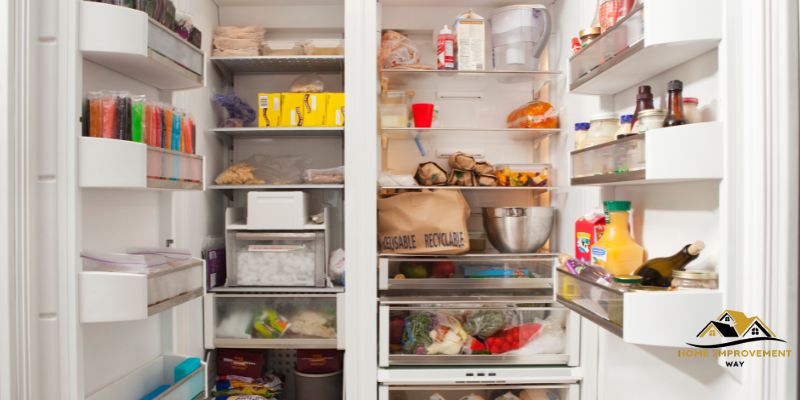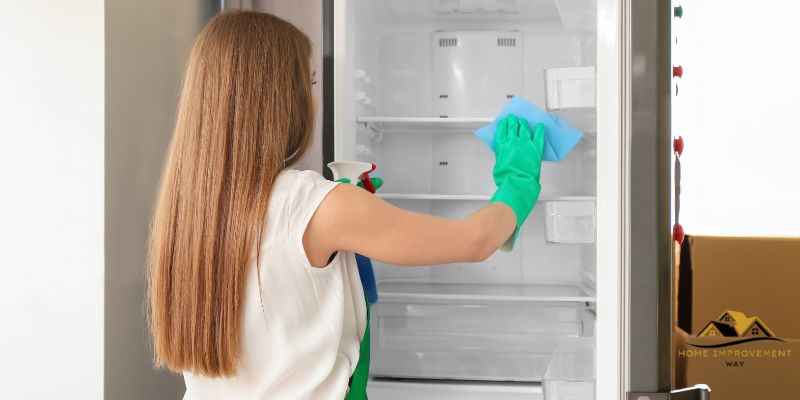To clean a moldy fridge, empty all the contents, remove shelves and drawers, mix mild soap and water, scrub thoroughly, rinse, and dry everything before putting it back. A moldy fridge can be a breeding ground for bacteria and can lead to unpleasant odors and potential health hazards.
Therefore, it’s essential to clean and disinfect it regularly. While cleaning, make sure to wear gloves and ventilate the area properly. This will help to prevent the spread of mold spores and ensure a clean and healthy fridge for storing food.
By following these simple steps, you can effectively clean a moldy fridge and maintain a safe and hygienic environment in your kitchen.
Clarity Mold In Fridges
Understanding mold in fridges is crucial for maintaining a clean and healthy kitchen. Learn effective ways to clean a moldy fridge, keeping it safe for storing food.
What Causes Mold In Fridges?
Mold in fridges is a common problem that can occur for a variety of reasons. Understanding what causes mold growth in fridges is the first step towards preventing it and keeping your fridge clean and safe for storing food.
One of the primary causes of mold in fridges is excess moisture. When moisture is present, such as from spills, condensation, or leaks, it creates the perfect environment for mold spores to grow and thrive. These spores can quickly spread and reproduce, leading to a moldy fridge.
Another cause of mold in fridges is food that has gone bad or is left to rot. When food items are not properly stored or discarded in a timely manner, they can become a breeding ground for mold. The mold can then spread to other areas of the fridge, contaminating other food items and causing an unpleasant odor.
Additionally, a lack of proper ventilation in the fridge can contribute to mold growth. Without adequate airflow, moisture can become trapped, creating a damp environment that promotes mold development. This is why it’s crucial to make sure the fridge is set at the correct temperature and that air can circulate freely.

Why Is It Important To Deep Clean A Moldy Fridge?
Deep cleaning a moldy fridge is essential for several reasons. First and foremost, mold poses health risks, especially if ingested or inhaled. Mold spores can cause allergic reactions, respiratory issues, and even infections. By thoroughly cleaning the fridge and removing any mold, you can ensure the safety of the food stored inside.
Furthermore, mold can affect the taste and quality of your food. If you’ve ever had a bite of something that tasted off or smelled strange, it could be due to mold contamination. Deep cleaning your fridge not only eliminates the mold but also helps preserve the freshness and flavor of your food.
Keeping a clean, mold-free fridge also helps prolong the life of your appliance. Mold can cause damage to the interior of the fridge, such as staining and deterioration of surfaces. Regular deep cleaning prevents mold buildup and ensures your fridge stays in optimal condition, ultimately saving you money on repairs or replacements.
Lastly, a clean and organized fridge is more efficient. Moldy spots can hinder proper airflow and cooling, leading to temperature inconsistencies and potential food spoilage. By regularly deep cleaning your fridge, you can maintain its efficiency and ensure your perishables stay fresh for longer.
Now that we understand the causes and importance of addressing mold in fridges, let’s explore how to properly clean a moldy fridge.
Preparing For The Deep Cleaning Process
Preparing for the deep cleaning process of a moldy fridge requires careful steps, such as removing all contents, discarding spoiled items, disinfecting surfaces with a vinegar solution, and installing odor absorbers for a fresh and clean outcome.
Gathering The Necessary Supplies
Before you begin the deep cleaning process for your moldy fridge, it’s essential to gather all the necessary supplies. Having everything you need at hand will ensure a smooth and efficient cleaning experience. Here are the supplies you’ll need:
- A pair of rubber gloves
- A face mask
- A bucket
- A sponge or cloth
- White vinegar
- Baking soda
- Warm water
- A scrub brush
- Dish soap
- Microfiber cloths
Make sure to wear rubber gloves and a face mask to protect yourself from the mold and any harsh chemicals you’ll be using during the cleaning process.
Ensuring Proper Ventilation
Proper ventilation is crucial when cleaning a moldy fridge, as it helps to prevent the spread of mold spores and improves air circulation. Follow these steps to ensure proper ventilation:
- Open all windows and doors in the kitchen to allow fresh air to enter.
- Switch on the exhaust fan, if you have one, to help remove any stagnant air and odors.
- If possible, place a portable fan near the fridge to promote air movement.
Ensuring proper ventilation will not only make the cleaning process more comfortable but also aid in preventing the mold from spreading to other areas of your kitchen.
Step-by-step Guide To Deep Clean A Moldy Fridge
Mold in your fridge is not only unsightly but also a health hazard. To ensure the safety of your food and maintain a clean and odor-free fridge, it is essential to deep clean it regularly. By following this step-by-step guide, you can effectively remove mold and prevent its future growth.
Emptying And Organizing The Fridge
Before you begin cleaning the moldy fridge, start by emptying its contents. Take out all the food items and place them in a cooler with ice to keep them fresh. As you remove the items, check for any spoiled or expired food and discard it. After emptying the fridge, take this opportunity to organize the remaining items by grouping similar foods together. This will make it easier to put them back later.
Removing And Cleaning Removable Parts
Many fridges have removable parts that are prone to mold growth, such as shelves, drawers, and door racks. Carefully take out these parts and place them in a sink filled with warm water and mild dish soap. Let them soak for a few minutes, then scrub them with a sponge or brush to remove any mold and dirt. Rinse the parts thoroughly and allow them to air dry before putting them back in the fridge.
Wiping Down Surfaces With Mold-fighting Solutions
Now it’s time to tackle the interior surfaces of your fridge. Prepare a solution of equal parts water and white vinegar or a mild bleach solution. Alternatively, you can use a commercial mold-fighting cleaner. Moisten a clean cloth or sponge with the solution and wipe down all the walls, shelves, and drawers. Pay extra attention to any areas with visible mold growth. Avoid using harsh chemicals or abrasive scrubbers as they may damage the fridge’s finish. After wiping down, leave the door open for a while to allow the fridge to air out.
Dealing With Stubborn Mold Spots
If you encounter stubborn mold spots that didn’t come off with the cleaning solution, you can create a paste by mixing baking soda and water. Apply the paste to the affected areas and let it sit for about 15 minutes. Then, scrub the spots gently with a soft brush or sponge. Rinse the area thoroughly with a clean cloth or sponge and the mold should be gone.
Cleaning The Fridge’s Exterior
Lastly, don’t forget about the exterior of your fridge. Use a mild cleaner suitable for the surface to wipe down the outside, including the handles and control panel. Pay attention to any dirt or stains that may have accumulated over time. Dry the exterior with a clean cloth to prevent streaks.
By following this step-by-step guide, you can effectively deep clean a moldy fridge and prevent mold from recurring. Regular maintenance and proper food storage will help ensure a clean and healthy environment for your kitchen.

Preventing Future Mold Growth In The Fridge
Mold growth in your fridge can be a frustrating and unhygienic problem. After cleaning your fridge thoroughly, it’s essential to take steps to prevent future mold growth. By following proper food storage practices and establishing regular maintenance and cleaning routines, you can keep your fridge mold-free and your food fresh. Let’s dive into these preventive measures to ensure a clean and healthy refrigerator.
Proper Food Storage Practices
One of the key ways to prevent mold growth in your fridge is to practice proper food storage. Here are some tips to keep in mind:
- Keep your food in airtight and leak-proof containers. This helps to maintain the freshness of your food and prevents moisture from accumulating, which can lead to mold growth.
- Before storing food in the fridge, make sure it’s completely cooled down. Hot or warm food can create condensation, which increases moisture levels in the fridge.
- Place items that are more prone to mold growth, such as fruits and vegetables, in the crisper drawer. This area is designed to control humidity levels, keeping your produce fresh and mold-free.
- Regularly check for expired or spoiled food and promptly remove them from the fridge. Mold can spread quickly from one item to another, so it’s essential to keep a close eye on your food inventory.
- Consider placing an open box of baking soda or activated carbon in your fridge to absorb odors and excess moisture. This can help create an environment less favorable for mold growth.
Regular Maintenance And Cleaning Routines
In addition to proper food storage practices, establishing regular maintenance and cleaning routines for your fridge is crucial for preventing mold growth. Here’s what you can do:
- Wipe down spills and moisture promptly to avoid allowing any dampness to linger in your fridge, which can contribute to mold growth.
- Clean your fridge at least once a month using a mild detergent and warm water. Pay special attention to removable parts like shelves and drawers, ensuring they are thoroughly cleaned and dried before placing them back in the fridge.
- Regularly defrost the freezer to prevent ice buildup, which can lead to mold growth. Follow the manufacturer’s instructions for defrosting and cleaning your freezer.
- Consider placing an open box of baking soda or a fridge deodorizer to absorb any lingering odors and maintain a fresh-smelling fridge.
By following these simple steps, you can effectively prevent mold growth in your fridge, keeping your food fresh and your family healthy. Remember, maintaining proper food storage practices and establishing regular cleaning routines are key to a mold-free refrigerator.
Conclusion
To wrap up, keeping your fridge clean and mold-free is essential for maintaining a healthy living environment. By following the simple steps outlined in this blog post, you can ensure your fridge stays fresh and safe for storing food. Regularly inspect and clean the fridge, remove any spoiled items, and use natural solutions like vinegar and baking soda to combat mold.
Remember to practice good hygiene and store food properly to prevent future mold growth. With these tips, you can enjoy a clean, odor-free fridge for years to come.


